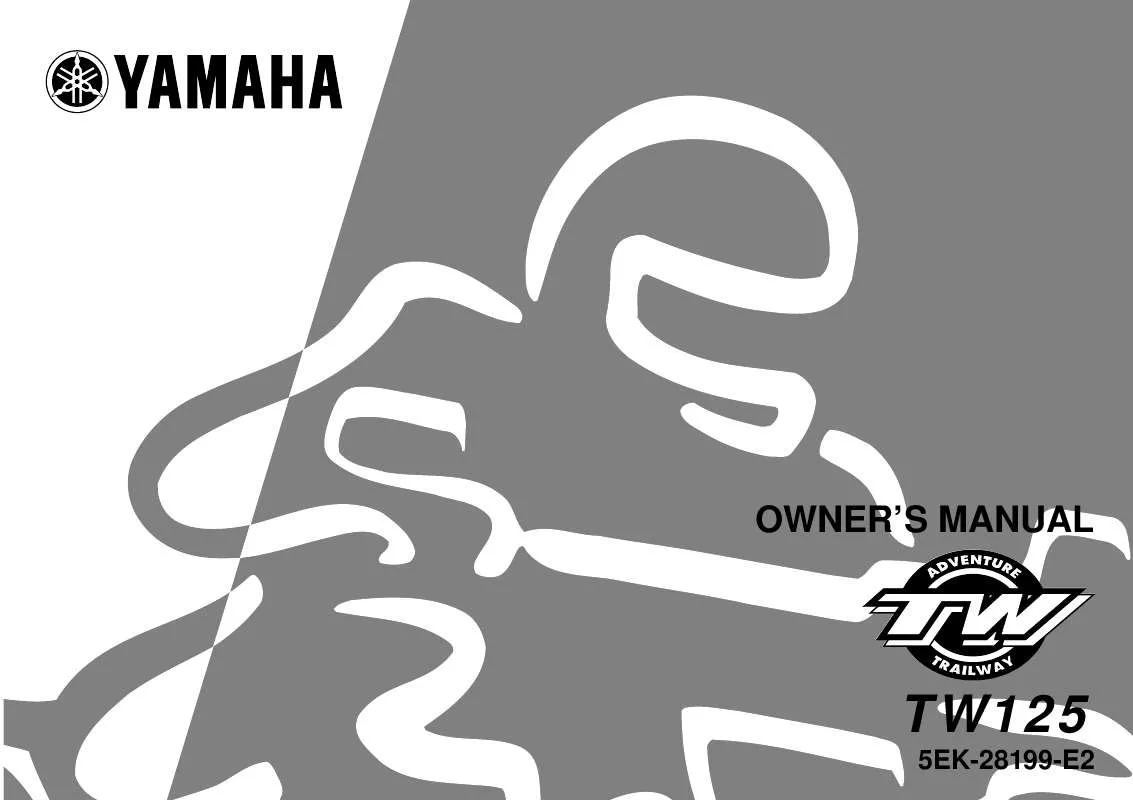Detailed instructions for use are in the User's Guide.
[. . . ] OWNER'S MANUAL
TW125
5EK-28199-E2
OWNER'S MANUAL
TW125
5EK-28199-E2
EAU03338
INTRODUCTION
Welcome to the Yamaha world of motorcycling!As the owner of a TW125, you are benefiting from Yamaha's vast experience and newest technology regarding the design and manufacture of high-quality products, which have earned Yamaha a reputation for dependability. Please take the time to read this manual thoroughly, so as to enjoy all advantages of your TW125. The owner's manual does not only instruct you in how to operate, inspect and maintain your motorcycle, but also in how to safeguard yourself and others from trouble and injury. [. . . ] To increase the throttle cable free play, turn the adjusting nut in direction a. To decrease the throttle cable free play, turn the adjusting nut in direction b. Tighten the locknut.
PERIODIC MAINTENANCE AND MINOR REPAIR
EAU00637 EAU03563
Adjusting the valve clearance
The valve clearance changes with use, resulting in improper air-fuel mixture and/or engine noise. To prevent this from occurring, the valve clearance must be adjusted by a Yamaha dealer at the intervals specified in the periodic maintenance and lubrication chart.
Tires
To maximize the performance, durability, and safe operation of your motorcycle, note the following points regarding the specified tires. Tire air pressure The tire air pressure should be checked and, if necessary, adjusted before each ride.
Load* Up to 80 kg
Tire air pressure (measured on cold tires) Front 150 kPa 1. 50 kg/cm2, 1. 50 bar 150 kPa 1. 50 kg/cm2, 1. 50 bar 125 kPa 1. 25 kg/cm2, 1. 25 bar Rear 150 kPa 1. 50 kg/cm2, 1. 50 bar 175 kPa 1. 75 kg/cm2, 1. 75 bar 125 kPa 1. 25 kg/cm2, 1. 25 bar
1 2 3 4
80 kg Maximum *
Off-road riding
Maximum load*
180 kg
w
EW000082
* Total weight of rider, passenger, cargo and accessories
5 6 7 8 9
8 The tire air pressure must be checked and adjusted on cold tires (i. e. , when the temperature of the tires equals the ambient temperature). 8 The tire air pressure must be adjusted in accordance with the riding speed and with the total weight of rider, passenger, cargo, and accessories approved for this model.
6-16
PERIODIC MAINTENANCE AND MINOR REPAIR
w
1 2 3 4 5 6 7 8 9
EWA00040
a
w
EW000079
Because loading has an enormous impact on the handling, braking, performance and safety characteristics of your motorcycle, you should keep the following precautions in mind. Operation of an overloaded motorcycle may result in tire damage, loss of control, or severe injury. Make sure that the total weight of rider, passenger, cargo, and accessories does not exceed the specified maximum load for the vehicle. 8 Do not carry along loosely packed items, which can shift during a ride. 8 Securely pack the heaviest items close to the center of the motorcycle and distribute the weight evenly on both sides. 8 Adjust the tire air pressure with regard to the load. 8 Check the tire condition and air pressure before each ride.
1
1. Tread depth
Tire inspection The tires must be checked before each ride. If the center tread depth reaches the specified limit, if the tire has a nail or glass fragments in it, or if the sidewall is cracked, have a Yamaha dealer replace the tire immediately.
Minimum tire tread depth (front and rear) 1. 6 mm
8 Have a Yamaha dealer replace excessively worn tires. Besides being illegal, operating the motorcycle with excessively worn tires decreases riding stability and can lead to loss of control. 8 The replacement of all wheeland brake-related parts, including the tires, should be left to a Yamaha dealer, who has the necessary professional knowledge and experience.
NOTE: The tire tread depth limits may differ from country to country. Always comply with the local regulations.
6-17
PERIODIC MAINTENANCE AND MINOR REPAIR
Tire information This motorcycle is equipped with tube tires.
w
EAU00681
EAU00685
Spoke wheels
To maximize the performance, durability, and safe operation of your motorcycle, note the following points regarding the specified wheels. 8 The wheel rims should be checked for cracks, bends or warpage, and the spokes for looseness or damage before each ride. If any damage is found, have a Yamaha dealer replace the wheel. Do not attempt even the smallest repair to the wheel. A deformed or cracked wheel must be replaced. 8 The wheel should be balanced whenever either the tire or wheel has been changed or replaced. [. . . ] 8 To prevent corrosion, avoid damp cellars, stables (because of the presence of ammonia) and areas where strong chemicals are stored.
w
EWA00003
To prevent damage or injury from sparking, make sure to ground the spark plug electrodes while turning the engine over.
7-4
MOTORCYCLE CARE AND STORAGE
6. Lubricate all control cables and the pivoting points of all levers and pedals as well as of the sidestand/centerstand. Check and, if necessary, correct the tire air pressure, and then lift the motorcycle so that both of its wheels are off the ground. Alternatively, turn the wheels a little every month in order to prevent the tires from becoming degraded in one spot. [. . . ]


